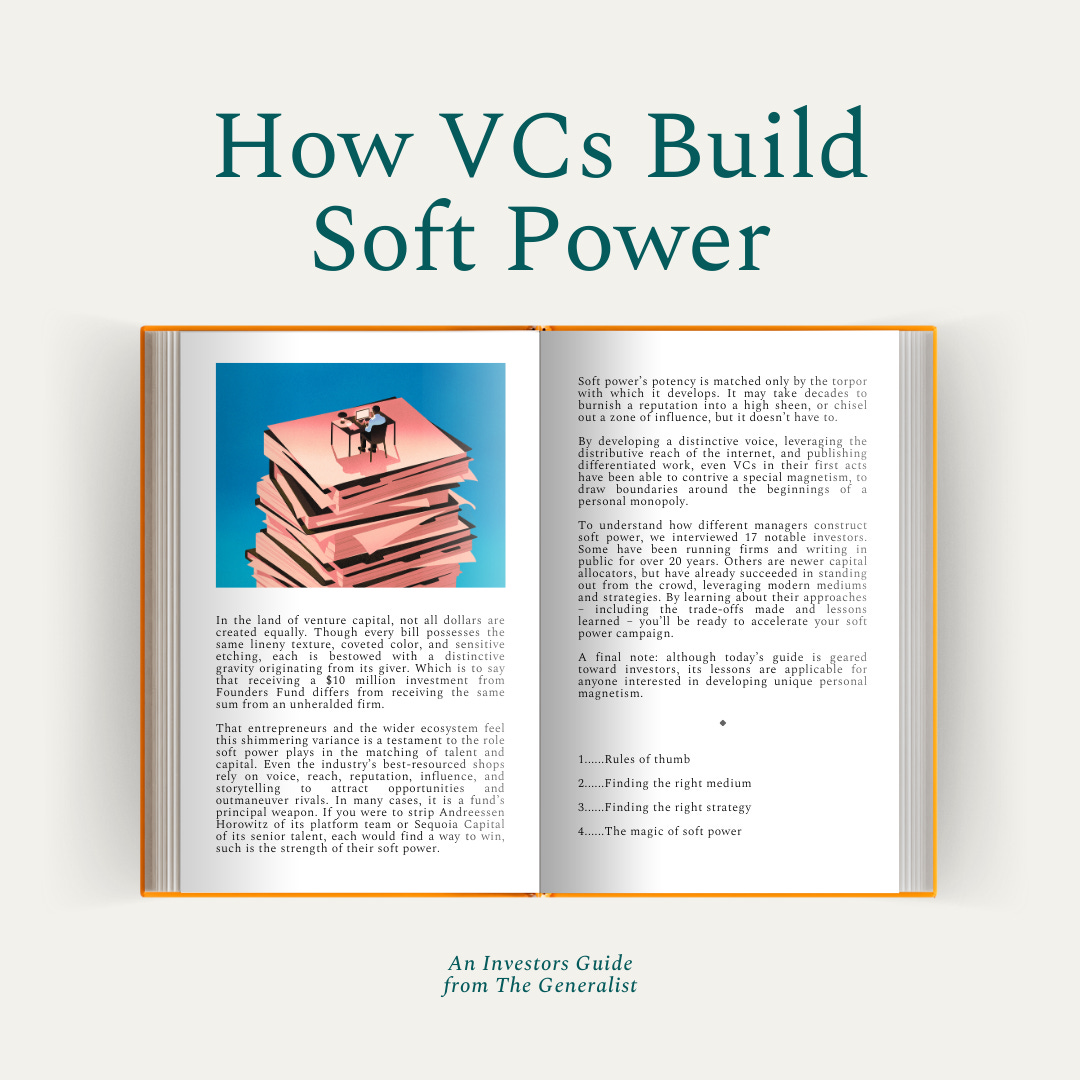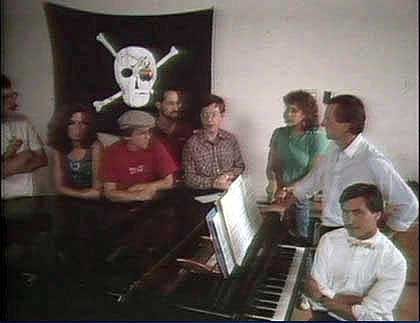🌟 Hey there! This is a subscriber-only edition of our premium newsletter designed to make you a better investor, founder, and technologist. Members get access to the strategies, tactics, and wisdom of exceptional investors and founders. Become a member today.
Friends,
In the land of venture capital, not all dollars are created equally. Though every bill possesses the same lineny texture, coveted color, and sensitive etching, each is bestowed with a distinctive gravity originating from its giver. Which is to say that receiving a $10 million investment from Founders Fund differs from receiving the same sum from an unheralded firm.
That entrepreneurs and the wider ecosystem feel this shimmering variance is a testament to soft power’s role in matching talent and capital. Even the industry’s best-resourced shops rely on voice, reach, reputation, influence, and storytelling to attract opportunities and outmaneuver rivals. In many cases, it is a fund’s principal weapon. If you were to strip Andreessen Horowitz of its platform team or Sequoia Capital of its senior talent, each would find a way to win, such is the strength of their soft power.
Soft power’s potency is matched only by the torpor with which it develops. It may take decades to burnish a reputation into a high sheen or chisel out a zone of influence, but it doesn’t have to. By developing a distinctive voice, leveraging the distributive reach of the Internet, and publishing differentiated work, even VCs in their first acts have been able to contrive a special magnetism, to draw boundaries around the beginnings of a personal monopoly.
To understand how different managers construct soft power, we interviewed 17 notable investors. Some have been running firms and writing in public for over 20 years. Others are newer capital allocators but have already succeeded in standing out from the crowd, leveraging modern mediums and strategies. By learning about their approaches – including the trade-offs made and lessons learned – you’ll be ready to accelerate your soft power campaign.
Although today’s guide is geared toward investors, its lessons are applicable to anyone interested in developing unique personal magnetism at scale.
What to expect
Master how to build and leverage soft power. We created an 11,000-word guide on architecting a personal brand and making it work for you. It features details and insights you won’t find elsewhere.
Learn from VCs who have done it. We compiled this guide by interviewing 17 VCs with soft power running differentiated strategies. The advice included is informed by practitioners in the arena, and the lessons they’ve learned.
Avoid common mistakes. In addition to our research, the VCs we’ve interviewed have pointed out their mistakes and what they wished they’d done differently. We’ve highlighted common pitfalls to ensure you side-step them and reap soft power’s rewards with less stress.
Understand how to pick a content strategy. There is no right way to build soft power. Rather, you must choose a medium and a strategy leveraging your unique strengths. We walk through the trade-offs and help you navigate the idea maze faster.
Hear how exactly investors benefit from soft power. Soft power is an intangible magic. Because of that, it can be difficult to understand its advantages. We dig into its benefits and explain why it’s well worth cultivating.
This guide is the result of months of interviewing and research. It is designed to deliver Silicon Valley’s practitioners’ best advice and strategies in a single edition.
Brought to you by Mercury
If Jony Ive built a banking* experience…
I think it would look a lot like Mercury. The Generalist has been a Mercury customer for years, and I’m constantly awed by the platform’s beauty, thoughtfulness, and power. It’s become a core part of how we run our business and is probably the only banking product I find a genuine pleasure to use.
Mercury’s banking experience isn’t just loved by The Generalist. 200K other startups trust it to simplify their finances and power essential workflows, like paying bills or sending invoices. By using Mercury, customers save time, get granular visibility into their finances, and have finer-toothed control over money movement.
Apply in minutes today at mercury.com to simplify your finances and perform at your best.
*Mercury is a financial technology company, not a bank. Banking services provided by Choice Financial Group and Evolve Bank & Trust®; Members FDIC.
Table of contents
1. Rules of thumb
Lower your shipping threshold
No tribute acts
Nothing too dear to kill
Fight the beige
Small is mighty
This is slow magic
2. Find the right medium
Writing
Podcasting
Social media
Other options
3. Find the right strategy
Selecting a strategy
Popularity vs. Influence
Consider the timing
4. The magic of soft power
Manufacturing serendipity
Build a network
Cultivate a prepared mind
Demonstrate your value
Thank you to Tomasz Tunguz (Theory), Frank Rotman (QED), Michael Dempsey (Compound), Nikhil Basu-Trivedi (Footwork), Niki Scevak (Blackbird), Rex Woodbury (Daybreak), Sajith Pai (Blume), Sarah Guo (Conviction), Sarah Tavel (Benchmark), Ann Miura-Ko (Floodgate), Charles Hudson (Precursor Ventures), Logan Bartlett (Redpoint), Zoe Weinberg (Ex/ante), Alex Taussig (Lightspeed), Kyle Samani (Multicoin) Nathan Benaich (Air Street), and Molly Mielke (Moth) for sharing their insights for this issue of the Investors Guide series.
1. Rules of thumb
Before learning how to generate soft power, understanding why it’s valuable in a venture context is worthwhile. For much of the asset class’s history, having a strong public presence wasn’t necessary, given the relative lack of competition. When Ann Miura-Ko and Mike Maples formed Floodgate, for example, little marketing was required:
Floodgate
In 2008, you didn’t even have to have a sign on your door. That has evolved.
– Ann Miura-Ko
As the asset class has grown, inviting greater and fiercer competition, the need to differentiate has increased, too. Critically, firms must do more than distinguish themselves – they must message those distinctions memorably, at scale. It is no good to hold a unique perspective or run an unusual model if entrepreneurs don’t know about it.
Frank Rotman of QED and Logan Bartlett of Redpoint articulated the importance of differentiation in today’s venture market.
QED
It was much easier when fintech was a very niche thing. When we started investing in 2008, only $1 billion was invested in fintech globally. At its peak, it hit $140 billion. Those two ecosystems are not the same, right? Being a big fish in a little pond is not that hard. When a founder was looking to raise, they just had to ask, “Who is active?” That, plus a few very public winners like SoFi and Credit Karma, helped us a lot initially.
One day, it occurred to me that we weren’t the only game in town anymore. It was going to be a lot easier for everyone to know who we were rather than us knowing who everyone was. Just being active was no longer enough. My strategy was: You have to have a voice.
– Frank Rotman
Redpoint
Differentiating is really, really hard. Once upon a time, you had to show up in a room with a founder and differentiate there. It allowed for more personality and the ability to earn trust over time rather than in a shorter, more finite, transactional period.
During COVID, I realized that space was no longer a bottleneck. Anyone could be on a Zoom screen. I was competing with people like Marc Andreessen, who started the web browser; or Roelof Botha and Doug Leone, who were parachuting into deals; or someone like Keith Rabois. And I didn’t know what to do, honestly.
I started to think about finding a potentially additive way of getting myself out there. I knew I needed to stand out somehow, but I didn’t know what form it would take. It ultimately required a few cycles to figure it out.
– Logan Bartlett
Creating that differentiation does not come easily. Many find it daunting to start “thinking in public,” either through writing, podcasts, or another medium. A few rules of thumb can help overcome initial nerves, find your unique voice, avoid blandness, and initiate the alchemical process. I wish I had known these before starting The Generalist, and as it happens, much of the advice VCs gave echoed it.
Lower your shipping threshold to start.
No tribute acts.
Nothing too dear to kill.
Fight the beige.
Small is mighty.
This is slow magic.
Lower your shipping threshold to start
There will always be a good reason not to write an article or record a podcast. It takes time, focus, possibly social or financial capital, and a degree of vulnerability. What if you say something stupid? What if an investor you admire disagrees with your fundamental premise? In the short term, there seems to be much more to lose than gain.
Because of that, lowering your shipping threshold in the early days can be helpful. If you try to create something utterly perfect out of the gate – especially if creating is new to you – you’ll likely stall out. A folder full of half-completed, unpublished blog posts is a sign that you’re stuck in this pattern. When you notice you’re falling into this kind of a cycle, narrow the scope of your project, lower your threshold for publishing, and get something out the door. As Steve Jobs told the Macintosh team in 1983: “Real artists ship.”
Sarah Guo is the founder of Conviction and the popular AI podcast No Priors. When she and co-host Elad Gil first weighed starting a creative collaboration, they explicitly considered devising a project they could commit to consistently shipping – even if it wasn’t perfect.
Conviction
No Priors was and still is a side project. Elad and I wanted to do something other than just an investment together, and we settled on a content or network thing. Then the question became: What’s the right format?
The theory was that a podcast would be the least amount of work. I think that theory was false, because all things are work.
Our view was that we wanted to do something we would enjoy and could maintain. We knew a lot of people in AI, and it’s a rapidly evolving sector, and people want to understand what’s happening. If all I had to do was talk to someone I thought was actually interesting, and where I might learn something, that felt like something I could do. We outsourced 99% of it and just made it about having the conversation and our relationship.
– Sarah Guo
As with No Priors, you may quickly find that even your “side project” generates meaningful interest.

Thinking in public may appear especially daunting for emerging, unproven managers. Who cares what I, a novice next to the industry’s luminaries, have to say? Benchmark’s Sarah Tavel, who began writing her popular blog in 2006 (now a Substack), flipped that framing:
Benchmark
The first posts I wrote were probably in 2006. The wonderful thing about blogging when you’re a nobody is that no one cares in the beginning. There’s no self-consciousness. Whereas, if you’re already established when you start blogging, many people can get anxious about it because they want to be good, impressive, or unique.
By starting when I was young, I could build this writing muscle. Over time, I began to realize more and more where my writing had the most resonance.
– Sarah Tavel
If you do not have an existing profile, lean into the freedom such a position affords.
Keeping your shipping threshold low may not be a practice to hold on to forever. Though it’s important to getting started, once you have more confidence in your creative abilities and have demonstrated your willingness to ship, you may find it’s more productive to raise your shipping threshold to maintain a high-quality bar.






